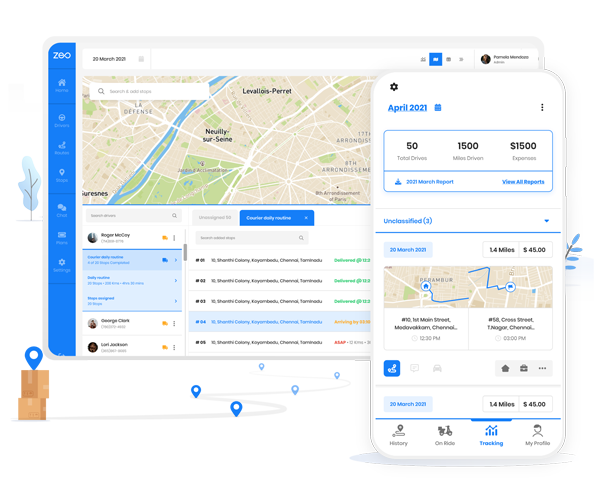Updated on: April 16, 2025
Ah, winter is here!
For many, it’s a time for cozy evenings, snowball fights, and hot cocoa. But ask a fleet manager in the snow plowing industry, and you’ll get a very different perspective.
While others enjoy the pristine beauty of freshly fallen snow, they’re battling logistical nightmares, unpredictable weather, demanding clients, and a race against time to keep roads and driveways safe.
The stakes are high. A missed route or delayed service isn’t just an inconvenience; it can lead to hazardous conditions, lost contracts, and frustrated customers. Snow doesn’t wait for anyone, but with the right route optimization strategy, you can make sure it doesn’t derail your operations.
Let’s dig into the key challenges and explore how route optimization can be a game-changer for snow plowing logistics.
Winter’s Wrath: Challenges of Snow Plowing Logistics
Optimizing snow plowing logistics isn’t just about clearing snow; it’s about doing it efficiently, safely, and on time. For fleet managers, the stakes are high, and poor routing or lack of route optimization can turn a demanding job into an overwhelming nightmare.
Let’s delve into the challenges that come with mismanaged routing in snow plowing logistics.
- Delayed Service in High-Priority Areas
When routes aren’t optimized, drivers often reach critical areas, like hospitals, schools, and main roads, later than they should. These delays can have serious consequences, from traffic standstills to restricted access for emergency services.
For fleet managers, the inability to optimize routes reduces the efficiency of snow plowing logistics, increases customer complaints, and damages their reputation for reliability.
- Escalating Fuel and Maintenance Costs
Without efficient routing, snow plow drivers travel longer distances and spend more time than they ideally should. Over time, this translates to skyrocketing fuel bills and accelerated wear and tear on plow trucks.
Fleet managers feel the financial pinch with shrinking profit margins and mounting maintenance expenses. This makes it harder to sustain operations through the winter season.
- Safety Risks for Drivers and the Public
When drivers have to navigate unoptimized routes, they may face increased exposure to unknown detours and hazardous road conditions. Backtracking through icy streets or taking longer, unplanned routes increases the likelihood of accidents.
This not only endangers drivers but also puts the public at risk, leading to liability concerns for fleet managers and additional downtime for repairs and insurance claims.
- Unmet Customer Expectations
In snow plowing logistics, client satisfaction hinges on timely service. A poorly routed fleet often results in missed deadlines, leaving residential and commercial clients frustrated.
Fleet managers must then deal with customer complaints, contract cancellations, and the risk of losing key accounts to competitors. The inability to meet expectations undermines business growth and long-term success.
- Inefficient Use of Peak Storm Windows
Timing is critical to the success of snow plowing logistics. Without optimized routes, fleets waste precious time navigating inefficient paths instead of clearing snow during peak storm windows.
This slows down overall operations, leaving roads and driveways uncleared for longer periods. Fleet managers are forced to stretch their resources, often at the cost of higher overtime pay and delayed service for other clients.
Also Read: How to Define your Snow Plowing Route?
Benefits of Route Optimization in Snow Plowing Logistics
Effective route optimization transforms snow plowing logistics by addressing the most pressing challenges head-on.
It’s not just about finding the shortest path, it’s about improving efficiency, safety, and customer satisfaction in this industry. Let’s dive into the specific benefits:

increase fuel savings
Save 2 Hours on Deliveries, Everyday!
Optimize routes with our algorithm, reducing travel time and costs efficiently.
Get Started for Free
- Faster Clearance During Peak Storms
Snowstorms are unpredictable, and poor routing can delay service to critical areas. Route optimization ensures your fleet clears roads in the most efficient order, focusing first on high-priority zones like hospitals, schools, or main thoroughfares.
This streamlined approach minimizes downtime and ensures essential services remain accessible, even during the harshest conditions.
Faster clearance builds trust and positions your business as a reliable partner for both municipalities and private clients.
- Lower Fuel and Maintenance Costs
Without optimized routes, vehicles cover unnecessary distances, burning excess fuel and increasing wear and tear. Route optimization reduces mileage by selecting the shortest, most direct paths and avoiding congested areas.
This not only lowers fuel consumption but also prolongs the life of your vehicles, cutting down on maintenance costs.
Over a season, these savings can significantly improve your bottom line, giving you more flexibility to grow your business.
- Improved Customer Satisfaction
For clients, time is everything. They want their driveways, parking lots, or streets cleared promptly after snowfall. Route optimization ensures timely service by prioritizing the shortest travel route possible.
Delivering consistent, on-time service enhances customer satisfaction and loyalty. Moreover, a reputation for reliability opens doors to new contracts and referrals.
- Enhanced Driver Productivity
Inefficient routes can leave drivers frustrated, overworked, or stuck in traffic. With optimized routing, drivers spend less time navigating and more time clearing snow.
This efficiency boosts morale, as drivers can complete their assignments without unnecessary stress.
A productive team not only delivers better results but also ensures that you can service more clients within the same timeframe, maximizing revenue potential.
- Minimized Risk of Accidents
Snow plowing comes with inherent dangers of icy roads, low visibility, and challenging terrain. Poorly planned routes increase these risks by sending drivers into unnecessary long detours and forcing them to backtrack through unplanned and unsafe routes.
Route optimization guides drivers along shorter, safer, well-timed routes that reduce the likelihood of accidents. Fewer incidents mean lower insurance costs and more consistent operations throughout the season while ensuring driver safety.
Conclusion
Snow plowing logistics is a tough business, but it doesn’t have to be chaotic. Route optimization is the key to unlocking efficiency, enhancing safety, and driving growth.
With tools like Zeo Route Planner, fleet managers can take the complexity out of their operations and focus on what truly matters, delivering exceptional service and staying ahead of the competition.
Don’t let poor planning snowball into bigger problems this winter. Take charge of your operations today.
Schedule a demo with Zeo experts and experience the transformative power of route optimization in snow plowing logistics.

Are you a fleet owner?
Want to manage your drivers and deliveries easily?
Grow your business effortlessly with Zeo Routes Planner – optimize routes and manage multiple drivers with ease.

increase fuel savings
Save $200 on fuel, Monthly!
Optimize routes with our algorithm, reducing travel time and costs efficiently.
Get Started for Free




















